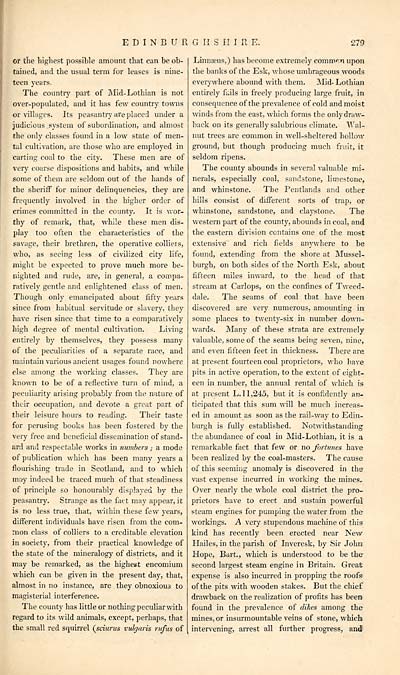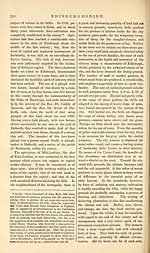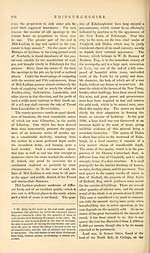Gazetteer of Scotland > Volume 1
(311) Page 279
Download files
Complete book:
Individual page:
Thumbnail gallery: Grid view | List view

EDINBURGH SHI R E.
Of the highest possible amount that can be ob-
tained, and the usual term for leases is nine-
teen years.
The country part of Mid-Lothian is not
over-populated, and it has few country towns
or villages. Its peasantry are placed under a
judicious system of subordination, and almost
the only classes found in a low state of men-
tal cultivation, are those who are employed in
carting coal to the city. These men are of
very coarse dispositions and habits, and while
some of them are seldom out of the hands of
the sheriff for minor delinquencies, they are
frequently involved in the higher order of
crimes committed in the county. It is wor-
thy of remark, that, while these men dis-
play too often the characteristics of the
savage, their brethren, the operative colliers,
who, as seeing less of civilized city life,
might be expected to prove much more be-
nighted and rude, are, in general, a compa-
ratively gentle and enlightened class of men.
Though only emancipated about fifty years
since from habitual servitude or slavery, they
have risen since that time to a comparatively
high degree of mental cultivation. Living
entirely by themselves, they possess many
of the peculiarities of a separate race, and
maintain various ancient usages found nowhere
else among the working classes. They are
known to be of a reflective turn of mind, a
peculiarity arising probably from the nature of
their occupation, and devote a great part of
their leisure hours to reading. Their taste
for perusing books has been fostered by the
very free and beneficial dissemination of stand-
ard and respectable works in numbers ; a mode
of publication which has been many years a
flourishing trade in Scotland, and to which
may indeed be traced much of that steadiness
of principle so honourably displayed by the
peasantry. Strange as the fact may appear, it
is no less true, that, within these few years,
different individuals have risen from the com-
mon class of colliers to a creditable elevation
in society, from their practical knowledge of
the state of the mineralogy of districts, and it
may be remarked, as the highest encomium
which can be given in the present day, that,
almost in no instance, are they obnoxious to
magisterial interference.
The county has little or nothing peculiar with
regard to its wild animals, except, perhaps, that
the small red squirrel (sciurus vulgaris rufus of
Linnaeus,) has become extremely comnonn upon
the banks of the Esk, whose umbrageous woods
everywhere abound with them. Mid- Lothian
entirely fails in freely producing large fruit, in
consequence of the prevalence of cold and moist
winds from the east, which forms the only draw-
back on its generally salubrious climate. Wal-
nut trees are common in well-sheltered hollow
ground, but though producing much fruit, it
seldom ripens.
The county abounds in several valuable mi-
nerals, especially coal, sandstone, limestone,
and whinstone. The Pentlands and other
hills consist of different sorts of trap, or
whinstone, sandstone, and claystone. The
western part of the county, abounds in coal, and
the eastern division contains one of the most
extensive and rich fields anywhere to be
found, extending from the shore at Mussel-
burgh, on both sides of the North Esk, about
fifteen miles inward, to the head of that
stream at Carlops, on the confines of Tweed-
dale. The seams of coal that have been
discovered are very numerous, amounting in
some places to twenty-six in number down-
wards. Many of these strata are extremely
valuable, some of the seams being seven, nine,
and even fifteen feet in thickness. There are
at present fourteen coal proprietors, who have
pits in active operation, to the extent of eight-
een in number, the annual rental of which is
at present L. 11,245, but it is confidently an-
ticipated that this sum will be much increas-
ed in amount as soon as the rail-way to Edin-
burgh is fully established. Notwithstanding
the abundance of coal in Mid-Lothian, it is a
remarkable fact that few or no fortunes have
been realized by the coal-masters. The cause
of this seeming anomaly is discovered in the
vast expense incurred in working the mines.
Over nearly the whole coal district the pro-
prietors have to erect and sustain powerful
steam engines for pumping the water from the
workings. A very stupendous machine of this
kind has recently been erected near New
Hailes, in the parish of Inveresk, by Sir John
Hope, Bart., which is understood to be the
second largest steam engine in Britain. Great
expense is also incurred in propping the roafa
of the pits with wooden stakes. But the chief
drawback on the realization of profits has been
found in the prevalence of dikes among the
mines, or insurmountable veins of stone, which
intervening, arrest all further progress, and :
Of the highest possible amount that can be ob-
tained, and the usual term for leases is nine-
teen years.
The country part of Mid-Lothian is not
over-populated, and it has few country towns
or villages. Its peasantry are placed under a
judicious system of subordination, and almost
the only classes found in a low state of men-
tal cultivation, are those who are employed in
carting coal to the city. These men are of
very coarse dispositions and habits, and while
some of them are seldom out of the hands of
the sheriff for minor delinquencies, they are
frequently involved in the higher order of
crimes committed in the county. It is wor-
thy of remark, that, while these men dis-
play too often the characteristics of the
savage, their brethren, the operative colliers,
who, as seeing less of civilized city life,
might be expected to prove much more be-
nighted and rude, are, in general, a compa-
ratively gentle and enlightened class of men.
Though only emancipated about fifty years
since from habitual servitude or slavery, they
have risen since that time to a comparatively
high degree of mental cultivation. Living
entirely by themselves, they possess many
of the peculiarities of a separate race, and
maintain various ancient usages found nowhere
else among the working classes. They are
known to be of a reflective turn of mind, a
peculiarity arising probably from the nature of
their occupation, and devote a great part of
their leisure hours to reading. Their taste
for perusing books has been fostered by the
very free and beneficial dissemination of stand-
ard and respectable works in numbers ; a mode
of publication which has been many years a
flourishing trade in Scotland, and to which
may indeed be traced much of that steadiness
of principle so honourably displayed by the
peasantry. Strange as the fact may appear, it
is no less true, that, within these few years,
different individuals have risen from the com-
mon class of colliers to a creditable elevation
in society, from their practical knowledge of
the state of the mineralogy of districts, and it
may be remarked, as the highest encomium
which can be given in the present day, that,
almost in no instance, are they obnoxious to
magisterial interference.
The county has little or nothing peculiar with
regard to its wild animals, except, perhaps, that
the small red squirrel (sciurus vulgaris rufus of
Linnaeus,) has become extremely comnonn upon
the banks of the Esk, whose umbrageous woods
everywhere abound with them. Mid- Lothian
entirely fails in freely producing large fruit, in
consequence of the prevalence of cold and moist
winds from the east, which forms the only draw-
back on its generally salubrious climate. Wal-
nut trees are common in well-sheltered hollow
ground, but though producing much fruit, it
seldom ripens.
The county abounds in several valuable mi-
nerals, especially coal, sandstone, limestone,
and whinstone. The Pentlands and other
hills consist of different sorts of trap, or
whinstone, sandstone, and claystone. The
western part of the county, abounds in coal, and
the eastern division contains one of the most
extensive and rich fields anywhere to be
found, extending from the shore at Mussel-
burgh, on both sides of the North Esk, about
fifteen miles inward, to the head of that
stream at Carlops, on the confines of Tweed-
dale. The seams of coal that have been
discovered are very numerous, amounting in
some places to twenty-six in number down-
wards. Many of these strata are extremely
valuable, some of the seams being seven, nine,
and even fifteen feet in thickness. There are
at present fourteen coal proprietors, who have
pits in active operation, to the extent of eight-
een in number, the annual rental of which is
at present L. 11,245, but it is confidently an-
ticipated that this sum will be much increas-
ed in amount as soon as the rail-way to Edin-
burgh is fully established. Notwithstanding
the abundance of coal in Mid-Lothian, it is a
remarkable fact that few or no fortunes have
been realized by the coal-masters. The cause
of this seeming anomaly is discovered in the
vast expense incurred in working the mines.
Over nearly the whole coal district the pro-
prietors have to erect and sustain powerful
steam engines for pumping the water from the
workings. A very stupendous machine of this
kind has recently been erected near New
Hailes, in the parish of Inveresk, by Sir John
Hope, Bart., which is understood to be the
second largest steam engine in Britain. Great
expense is also incurred in propping the roafa
of the pits with wooden stakes. But the chief
drawback on the realization of profits has been
found in the prevalence of dikes among the
mines, or insurmountable veins of stone, which
intervening, arrest all further progress, and :
Set display mode to: Large image | Transcription
Images and transcriptions on this page, including medium image downloads, may be used under the Creative Commons Attribution 4.0 International Licence unless otherwise stated. ![]()
| Gazetteers of Scotland, 1803-1901 > Gazetteer of Scotland > Volume 1 > (311) Page 279 |
|---|
| Permanent URL | https://digital.nls.uk/97428094 |
|---|
| Description | Volume I: Abbey to Glenartney. |
|---|---|
| Attribution and copyright: |
|
| Description | By Robert Chambers and William Chambers. Glasgow: Blackie & Son, 1838. 2 volumes. |
|---|---|
| Shelfmark | NF.1461.g.7 |
| Additional NLS resources: | |

